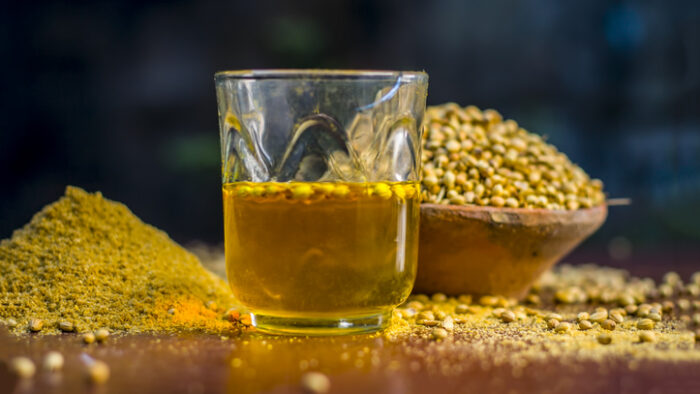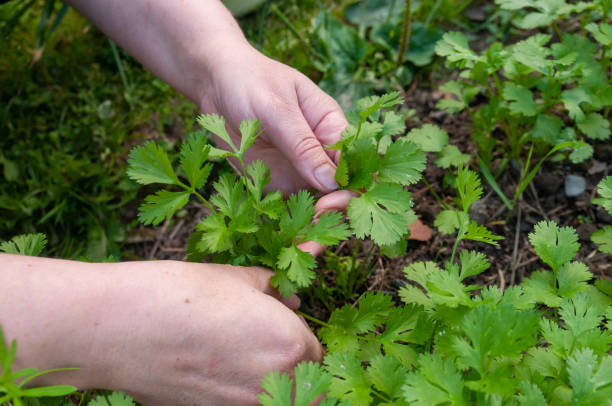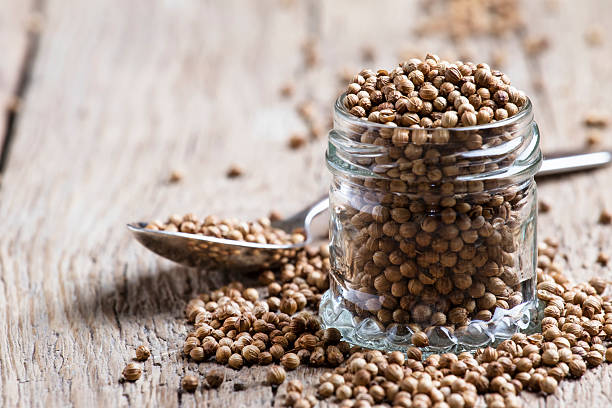Dhaanya or coriander (Coriandrum sativum) is used widely in every corner of India. Known as dhaanyaka in Sanskrit, it is also known as Chinese parsley, as cilantro in the USA, and as coriander leaves in most of the non-Indian world
Ayurveda advises that only foods that produce cooling inside the cells will actually cool our body. The ancient texts of Ayurveda gave us the original sweet cooling drinks, from which today's modern cold drinks and ice sodas and carbonated beverages have evolved. Ayurveda's preparations used ingredients that naturally cooled the body without halting the metabolism inside, essentially reducing radiant heat loss from each cell's factory. These sweet cooling drinks are known as pānaka, described in the pākaśāstra, texts of Ayurveda devoted to the topics of dietetics, culinary arts and the science and art of cooking (paka, S., to cook).
Preparations of cool drinks were made with cane sugar, green unripe mango, ripe tamarind and lemon, buttermilk and digestive herbs such as coriander, black pepper, cloves, cardamom and camphor. These ingredients were known as pittashamaka, destroying the radiant heat of pitta to give a cooling effect.
The Indian kitchen spice dhaanya or coriander (Coriandrum sativum) is used widely in every corner of India. Known as dhaanyaka in Sanskrit, it is also known as Chinese parsley, as cilantro in the USA, and as coriander leaves in most of the non-Indian world.
Two parts of this plant have medicinal value. The plant's fruits, known technically as schizocarps, are known as coriander seeds or dhaanya beej because each fruit splits in half to produce two seeds. These whole, light-brown round dry fruits are commonly mis-called coriander seeds. The green light feathery leaves of the plant come with long flimsy stems and have an unmistakable smell.
According to Ayurvedic wisdom, dhaanyaka leaves have microbe-killing properties (krimighna) due to metal chelators stored within the dark-green leaves, and those same metals and minerals assist in hair growth (keshya). Dhaanyaka leaves improve the ability to taste (ruchikara) and thus improve appetite.
Dhaanya beej, the dry fruits of coriander known on the spice rack as coriander seeds, are pittashamaka, and effective for cooling the body inside. Throughout late spring and early summer, prescriptions are given by Ayurvedic physicians for making coriander seed-infused water each night for drinking in the first half of the day. Consumed daily, this water gradually cools the body noticeably and acts as a health supplement to protect our body from trapped heat.
A pānaka preparation made from coriander seeds (dhanya beej) is described in the 15th century classic Ayurvedic text called Bhava Prakasha, written by the ancient physician Bhava Misra, a native of southwestern Bengal. In the recipe, the fine powder of dried dhanya seed-fruits are utilised.
********************************
धान्यकपानक
शिलायां साधु सम्पिष्टं धान्याकं वस्त्रगालितम् |
शर्करोदकसंयुक्तं कर्पूरादिसुसंस्कृतम् |
नूतने मृण्मये पात्रे स्थितं पित्तहरं परम् ||१३६||
Bhava Prakasha Nighantu, kṛtanna varga, chapter 12, slokas 136
Transliteration: dhānyakapānaka
śilāyāṁ sādhu sampiṣṭaṁ dhānyākaṁ vastragālitam |
śarkarōdaka-saṁyuktaṁ karpūrādisusaṁskr̥tam |
nūtanē mr̥ṇmayē pātrē sthitaṁ pittaharaṁ param ||136||
Translation: Freshly-dried coriander seeds (dhānyākaṁ) are mashed (piṣṭaṁ) by using a stone slab and stone cylindrical pestle known as sil-batta (śila), then filtered through a sieve (vastragālitam) made by using a clean cotton cloth (vastra) to obtain very fine powder. Separately, fresh natural water mixed with red cane sugar (śarkarōdaka) is made and put in an earthen pot, which is naturally cooling. Then the coriander powder is added (saṁyuktaṁ). Finally, karpura is added and mixed thoroughly. The liquid should be kept in the earthen pot until ready to drink. This is considered one of the best (param) pitta reducers (pittaharaṁ).
********************************
Dhānyaka-pānaka
 Ingredients
Ingredients
Fresh dried coriander fruits (seeds), crushed and sieved – 10 g (about 2 tsp)
Clean cotton cloth, finely woven like muslin
Fresh clean water - 1 litre
Red cane sugar, freshly ground - 20 g (about 4 tsp)
Earthen pot - 1.5 litre capacity
Camphor/karpura -1 g
Recipe
From your garden or from a local market, fresh dried dhaanya beej is collected and then washed carefully by hand to remove any small stones or dust particles. After washing, it is purified by drying in the sun (atapa) for two hours on a cloth or non-metallic surface. Then it is mashed completely by using the flat stone called śila using a cylindrical stone called batta. No metal should be used, as it generates mechanical heat.
After filtering the powder through the sieve of a fine cotton cloth, take 2 teaspoons of fine coriander seed powder and place it in a small bowl. Into an earthen pot, add 1000ml water that has been boiled then naturally cooled to room temperature. Add 4 teaspoons of red cane sugar that has been freshly ground to powder; freshly made pure red cane sugar does not raise blood sugar levels. Add the dhaanya powder and 1 gram of fresh karpura/camphor. Stir well for five minutes, adding prayers for good health. Keep in the earthen pot for two hours. Serve with a smile. The rims of the serving glasses may be lined with fresh-powdered red cane sugar.







